Photo / Video News & Reviews
Scubaverse Underwater Photographer Interview: Mario Vitalini
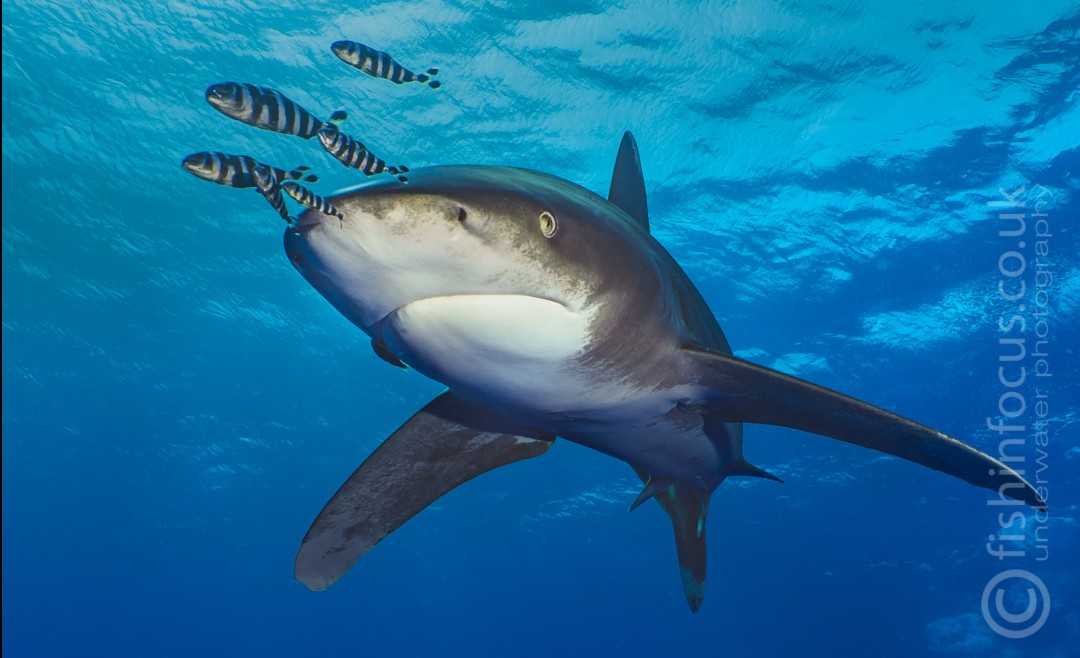
In an ongoing series, Scubaverse.com’s Underwater Photography Editors Nick and Caroline Robertson-Brown talk to underwater photographers from around the world that they admire.
This week’s interview is with UK-based tour operator Scuba Travel’s new resident underwater photo pro, Mario Vitalini.
[hr style=”single”]
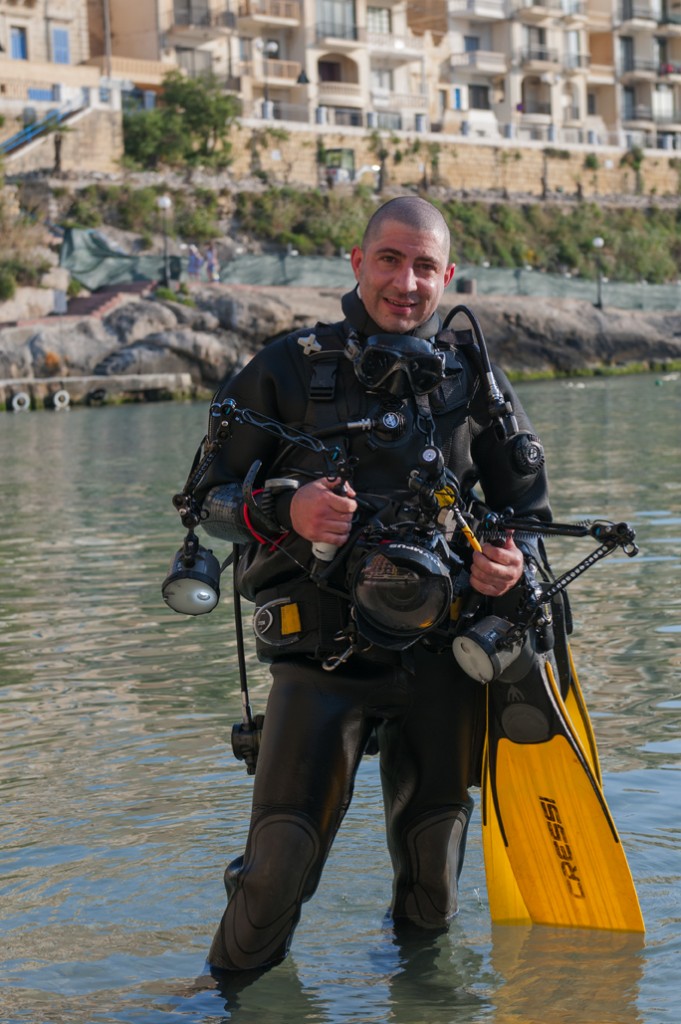 My name is Mario Vitalini, and photography is in my blood. I was born in Colombia some forty odd (cough) years ago. My father was a professional photographer and I grew up in his studio playing between tripods lights and large format cameras. I trained as graphic designer and worked as an art director for a few years, but the lure of the sea was too strong and I soon became a dive instructor and never looked back.
My name is Mario Vitalini, and photography is in my blood. I was born in Colombia some forty odd (cough) years ago. My father was a professional photographer and I grew up in his studio playing between tripods lights and large format cameras. I trained as graphic designer and worked as an art director for a few years, but the lure of the sea was too strong and I soon became a dive instructor and never looked back.
It was only a matter of time before I got hold of a Nikkonos camera and started taking photos underwater. As a dive instructor, I soon found myself working in Egypt where for some time I combined my job as a liveaboard guide with a video rig filming customers on the trips.
The passion for underwater photography was never far away and when together with my now wife we moved to the UK, and I found a job with one of the major underwater photography equipment retailers. This allowed me to get my hands on a huge range of equipment, which I tried on many trips, and helped pinpoint their strengths and weakness.
I left my job in retail some four years ago and started my own company teaching underwater photography on 1:1 basis to many enthusiastic divers. I decided to focus on 1:1 teaching as you get to see a real improvement in the students. There are no compromises as the course is totally focused on that individual. It’s really rewarding to see the speed at which people improve in a single day. Now I’m looking to take that ethos to a broader group. Think personalised content in a relaxed environment of fellow divers who are all looking to bring their own standard up.
[hr style=”single”]
N&C: How did your underwater photography start?
MV: Seeing my lifelong passion for photography combine with my then newfound passion of diving (somewhere in the 80s). My father gave me a second hand Nikkonos camera when I was a relatively new diver. I first used it on a trip to Cocos. Stan Waterman happened to be on that trip – wow, what an inspiration to follow your dreams. Without any formal training , the results were not very good back then, but that only inspired me to learn the differences between shooting on land and underwater.
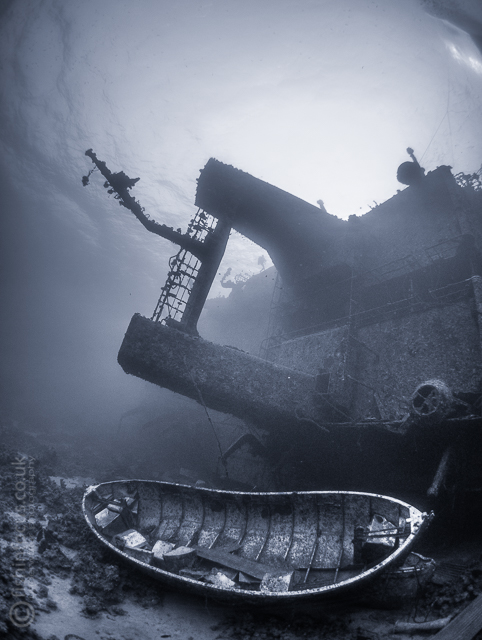
N&C: What is your favourite u/w camera equipment (past & present) & why?
MV: If we go back to film days, I have very good memories of my old Nikkonos 3. It’s simplicity and complete lack of electronics meant you had to learn to read the ambient light and to control your flashguns if you wanted to get any decent results. It also was in many ways flood resistant. If there was a leak, you just had to rinse it thoroughly and let it dry before loading another roll of film and carry on shooting.
Nowadays I’m a big fan of the mirrorless revolution. It’s exciting! These cameras are getting very close in image quality to what you can achieve with much, much more expensive, high end DSLR options. There are a few areas where there is still a noticeable difference but overall they are an excellent option. Low end and mid range DSLRs are like for like in terms of image quality. I currently use an Olympus OMD EM1 and love how practical it is to travel with a smaller, lighter set up.
N&C: What would be your advice to anyone new to underwater photography?
MV: There are a couple of things I would say to anyone looking to start to take pictures underwater. First of all, get your buoyancy spot on. When you are taking pictures underwater your focus is on the view finder, and you positioning should be second nature. Good buoyancy is the most important skill in underwater photography.
When it comes to choosing your kit, you should always ask yourself the question: Are you diving to take pictures or taking pictures while diving?
When you dive with a big photo set up (DSLR/Mirrorless, strobes, dome ports etc.) your get in the water to take pictures. If you enjoy diving and want to take pictures, a big system will only get in your way. You’ll save money in the long term by getting proper advice based on your personal goals.
Finally, remember that a great camera on land is not necessary a great camera underwater. The housing, accessories and ability to access functionality underwater all massively change the options. And few online review sites will cover these specific aspects.

N&C: What, or who, has been your single biggest inspiration for your underwater photography?
MV: I grew up watching Jacques Cousteau documentaries and I would say he is responsible for my love for the sea. Combined with my upbringing in a photographic environment I think it was only a matter of time before I got involved in underwater photography. Today I love what Keri Wilk does with macro and Alex Mustard and David Doubilet are both incredible masters of managing lighting. The colours are spectacular as well as creative images.
N&C: What are your boundaries on post-editing image manipulation?
MV: I do not have any problems with post processing. For me photography is an art form and as such it should not be restricted. However, I try to always show a real representation of the environment I’m photographing. Sometimes a great shot is ruined by a small element in the wrong place and then I do not have a problem retouching it. But when it comes to competitions it’s worth checking the rules and sticking to them. Some of the images I’m proudest of, and that have also done well in competitions, have had tonal manipulations. I love playing with black and whites, monotones and desaturations. These enhance an atmosphere that was there in the shot at the time, rather than adding or removing anything artificial.
RAW files require some amount of post processing and I do not think it’s realistic to completely ban photo editing. Tonal corrections and white balance, contrast and general exposure are necessary to get the most out of your RAW images. BUT: you should always aim to start with the best possible image.
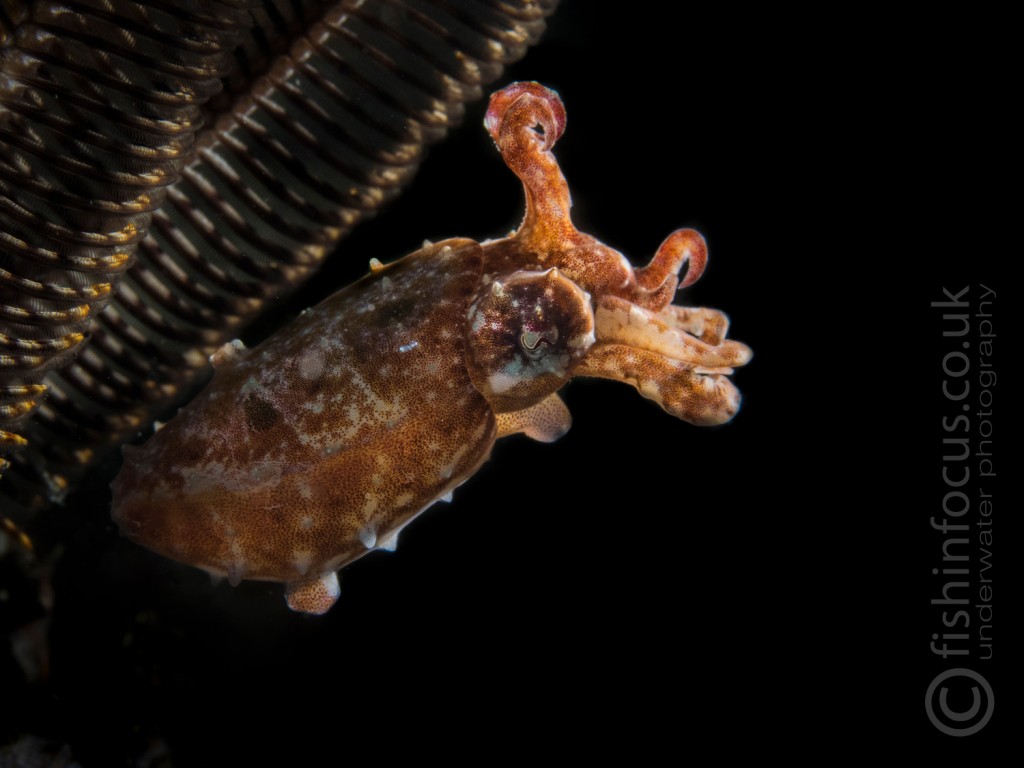
N&C: Where is your favourite dive location, and is it for the photography?
MV: I’ve been asked that question many times and I do not think I have a straight answer. I have been lucky to visit many destinations and each one has its own attraction, from the crazy macro encounters of Lembeh or Dumaguete, straight to the mind blowing diversity of Komodo or the sharks of Socorro and Palau. I grew up diving in the Caribbean and I will always have a soft spot for it.
If I have to choose a single destination it would probably be the Red Sea. Its not by chance I spent more than 5 years working as a dive guide there – I’ve dived it from north to south and every inch of it captivates me. There is always something special regardless of the season: great wrecks, beautiful reefs, pelagics and reef dwellers, generally good underwater conditions and great weather year around… what’s not to love? No surprise the Red Sea is one of the top destinations for divers from all over the world.
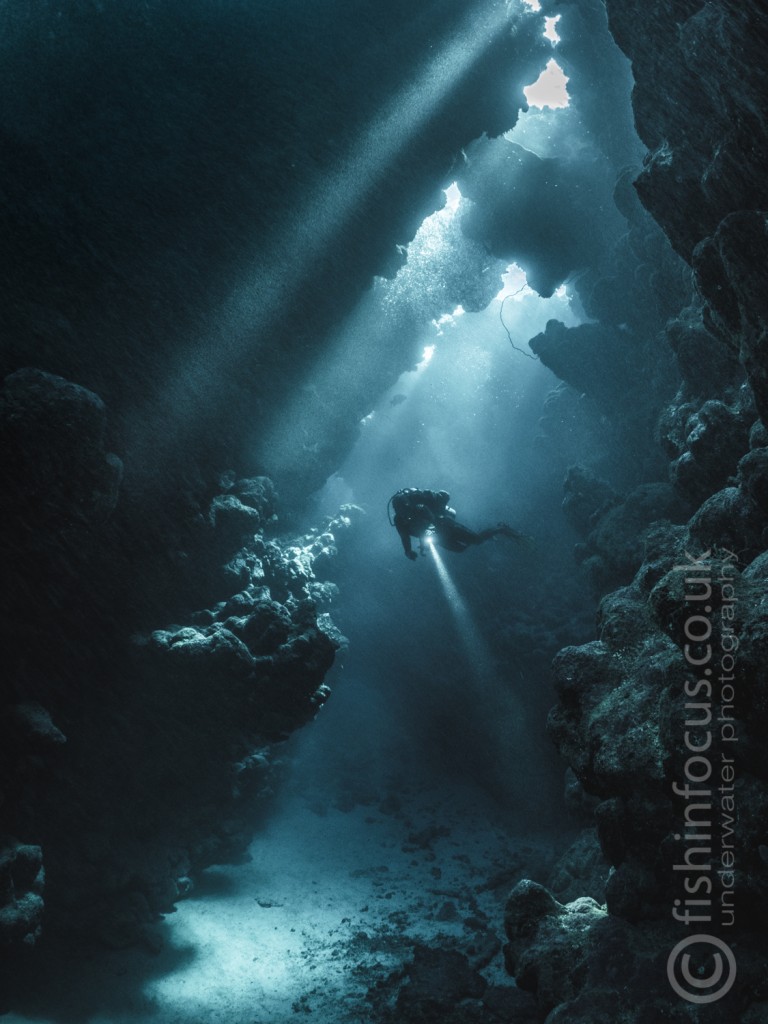
N&C: What are you views on marine life manipulation, moving subjects?
MV: In very simple terms, NOT ACCEPTABLE. This issue has been in the spotlight for some time now and unfortunately in many parts of the world it is something that often happens. As underwater photographers we have a responsibility to correct this bad behaviour. I have to mention good buoyancy comes hand in hand here; no photo is worth harassing marine life or destroying the environment. Simply put, don’t be one of “those” photographers or as it’s known in my house “a selfish twat”.
N&C: What do you look for when you are making your images?
MV: When I get underwater with my camera system I’m open to whatever I can find. There is always something interesting to photograph. When I find a subject I always take a few shots “for the record”, but afterwards I tend to put my camera down and look at the subject trying to find a different way to photograph it, using the environment to enhance it or lighting and different techniques to isolate it. Always look for a different and unusual take. We’ve all taken fish ID shots. There’s nothing wrong with getting a few of those in the bag, but then push yourself to go a step further. It takes time for sure. But with the right guides and buddy, it’s not about how much of a site you see, rather what you do with what you find.
N&C: What motivates you to take u/w photos?
MV: As scuba divers we encounter incredible creatures and fantastic places. Photographing the journey is a way to share my passion for the sea and its secrets. I’m as much in love with the sea in all its challenging and miraculous ways as I was as a 6 year old watching Cousteau in my parent’s living room in Colombia. I’ve just never seen it all – or enough!
N&C: If you could photograph any one thing/place what or where would that be?
MV: Instead of getting smaller, my wish list grows every day. If I had to pick a single subject it would be a blue whale. These magnificent animals are so impressive and very rarely photographed underwater. It would be an absolute dream to have the chance to photograph one. And if I had to pick a location it would be a close call between Galapagos and Silfra fissure. Damn… that’s two. Well, you get the idea. The list never gets shorter!
[hr style=”single”]
For more from Mario, visit www.fishinfocus.co.uk or www.facebook.com/fishinfocus.
To find out more about the liveaboard photo workshops that Mario runs for Scuba Travel click here.
Blogs
Diver Discovering Whale Skeletons Beneath Ice Judged World’s Best Underwater Photograph
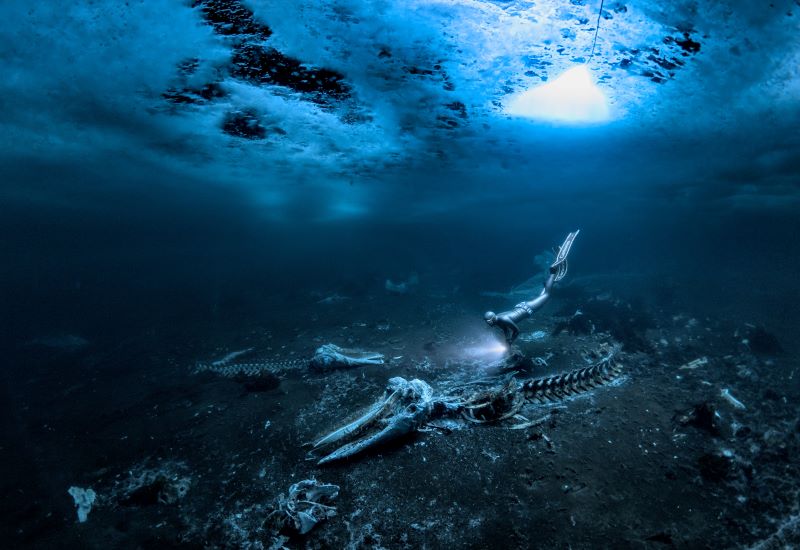
An emotive photograph showing a freediver examining the aftermath of whaling sees
Alex Dawson from Sweden named Underwater Photographer of the Year 2024. Dawson’s
photograph ‘Whale Bones’ triumphed over 6500 underwater pictures entered by underwater
photographers from around the world.
“Whale Bones was photographed in the toughest conditions,” explains chair of judging
panel Alex Mustard, “as a breath-hold diver descends below the Greenland ice sheet to bear
witness to the carcasses. The composition invites us to consider our impact on the great
creatures of this planet. Since the rise of humans, wild animals have declined by 85%. Today,
just 4% of mammals are wildlife, the remaining 96% are humans and our livestock. Our way
needs to change to find a balance with nature.”
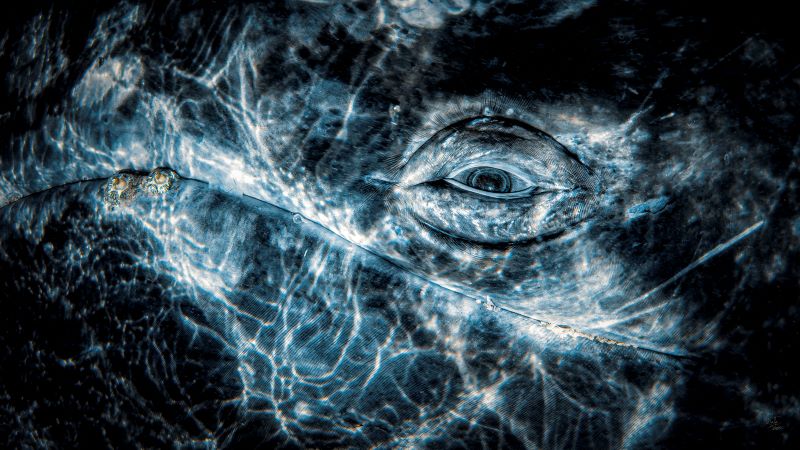
Photo: Rafael
Fernandez Caballero
Whales dominated the winning pictures this year with Spanish photographer Rafael
Fernandez Caballero winning two categories with his revealing photos of these ocean giants:
a close up of a grey whale’s eye and an action shot of a Bryde’s whale engulfing an entire bait
ball, both taken in Magdalena Bay, Baja California, Mexico. Fernandez Caballero took ‘Grey
Whale Connection’ while drifting in a small boat, holding his camera over the side in the water
to photograph the curious whale. ‘The End Of A Baitball’ required Fernandez Caballero to dive
down and be in exactly the right place at the moment the whale lunged. “The photo shows
the high speed attack,” he said, “with the whale engulfing hundreds of kilograms of sardines
in one bite — simply unforgettable to see predation on such a scale.”
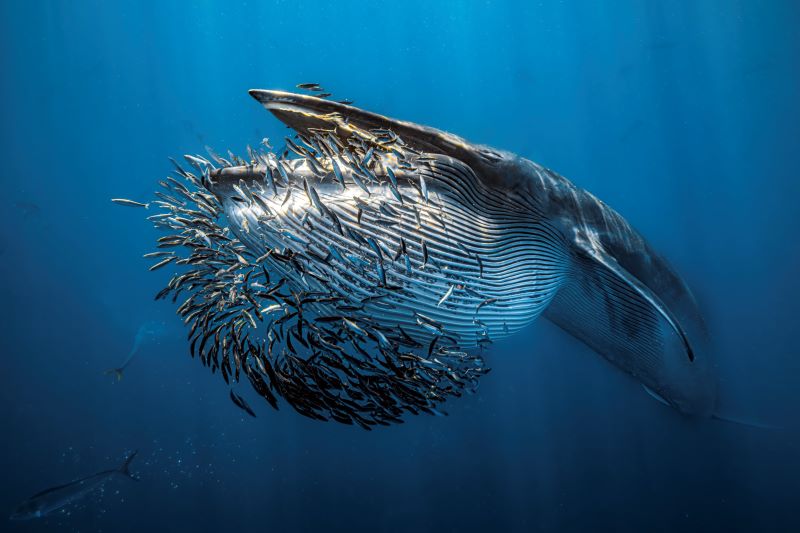
Photo: Rafael
Fernandez Caballero
Lisa Stengel from the United States was named Up & Coming Underwater Photographer of the Year 2024 for her image of a mahi-mahi catching a sardine, in Mexico. Stengel used both a very fast shutter speed and her hearing to catch the moment. “If you listen there’s an enormous amount of sound in the ocean,” she explained. “The action was too fast to see, so I honed in on the sound of the attacks with my camera to capture this special moment.”
“It is such an exciting time in underwater photography because photographers are capturing such amazing new images, by visiting new locations and using the latest cameras,”
commented judge Alex Mustard. “Until this year I’d hardly ever see a photo of a mahi mahi,
now Lisa has photographed one hunting, action that plays out in the blink of an eye.”
The Underwater Photographer of the Year contest is based in the UK, and Jenny Stock,
was named as British Underwater Photographer of the Year 2024 for her image “Star
Attraction”, which finds beauty in species of British wildlife that are often overlooked.
Exploring the west coast of Scotland, Stock explained “in the dark green depths my torch
picked out the vivid colours of a living carpet of thousands of brittle stars, each with a
different pattern. I was happily snapping away, when I spotted this purple sea urchin and I
got really excited.”
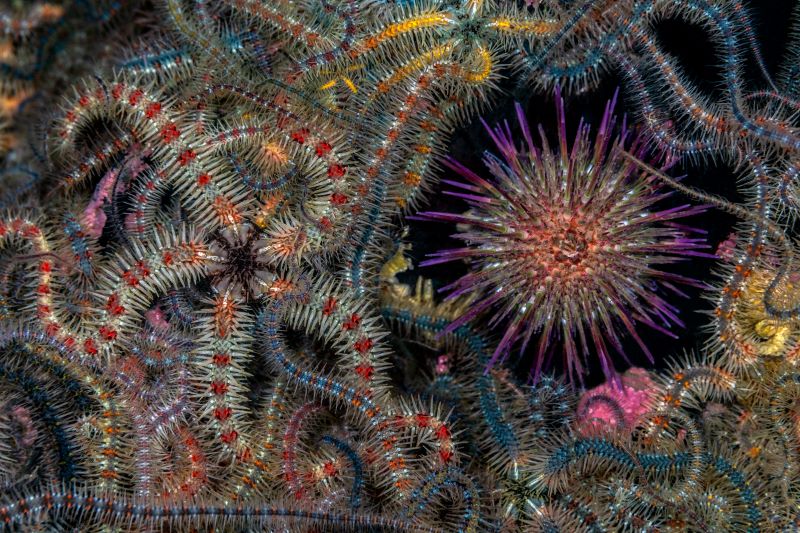
Photo: Jenny Stock
In the same contest, Portuguese photographer, Nuno Sá, was named ‘Save Our Seas
Foundation’ Marine Conservation Photographer of the Year 2024, with his photo ‘Saving
Goliath’, taken in Portugal. Sá’s photo shows beachgoers trying to save a stranded sperm
whale. The picture gives us hope that people do care and want to help the oceans, but also
warns us that bigger changes are needed. “The whale had been struck by a ship and its fate
was sealed,” explains Sá. “An estimated 20,000 whales are killed every year, and many more
injured, after being struck by ships-and few people even realise that it happens.”
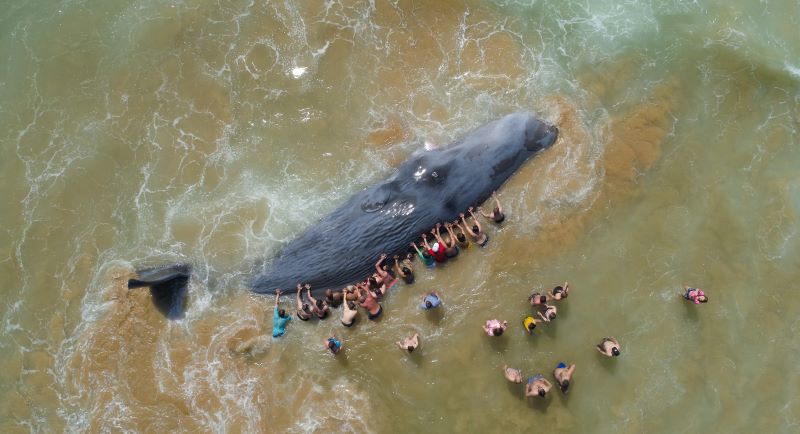
Photo: Nuno Sá
More winning images can be found at www.underwaterphotographeroftheyear.com.
About Underwater Photographer of the Year
Underwater Photographer of the Year is an annual competition, based in the UK, that celebrates photography beneath the surface of the ocean, lakes, rivers and even swimming pools, and attracts entries from all around the world. The contest has 13 categories, testing photographers with themes such as Macro, Wide Angle, Behaviour and Wreck photography, as well as four categories for photos taken specifically in British waters. The winners were announced in an award ceremony in Mayfair, London, hosted by The Crown Estate. This year’s UPY judges were experienced underwater photographers Peter Rowlands, Tobias Friedrich and Dr Alexander Mustard MBE.
Header image: Underwater Photographer of the Year 2024 winner Alex Dawson
News
World’s Best Underwater Photographers Unveil Breathtaking Images at World Shootout 2023
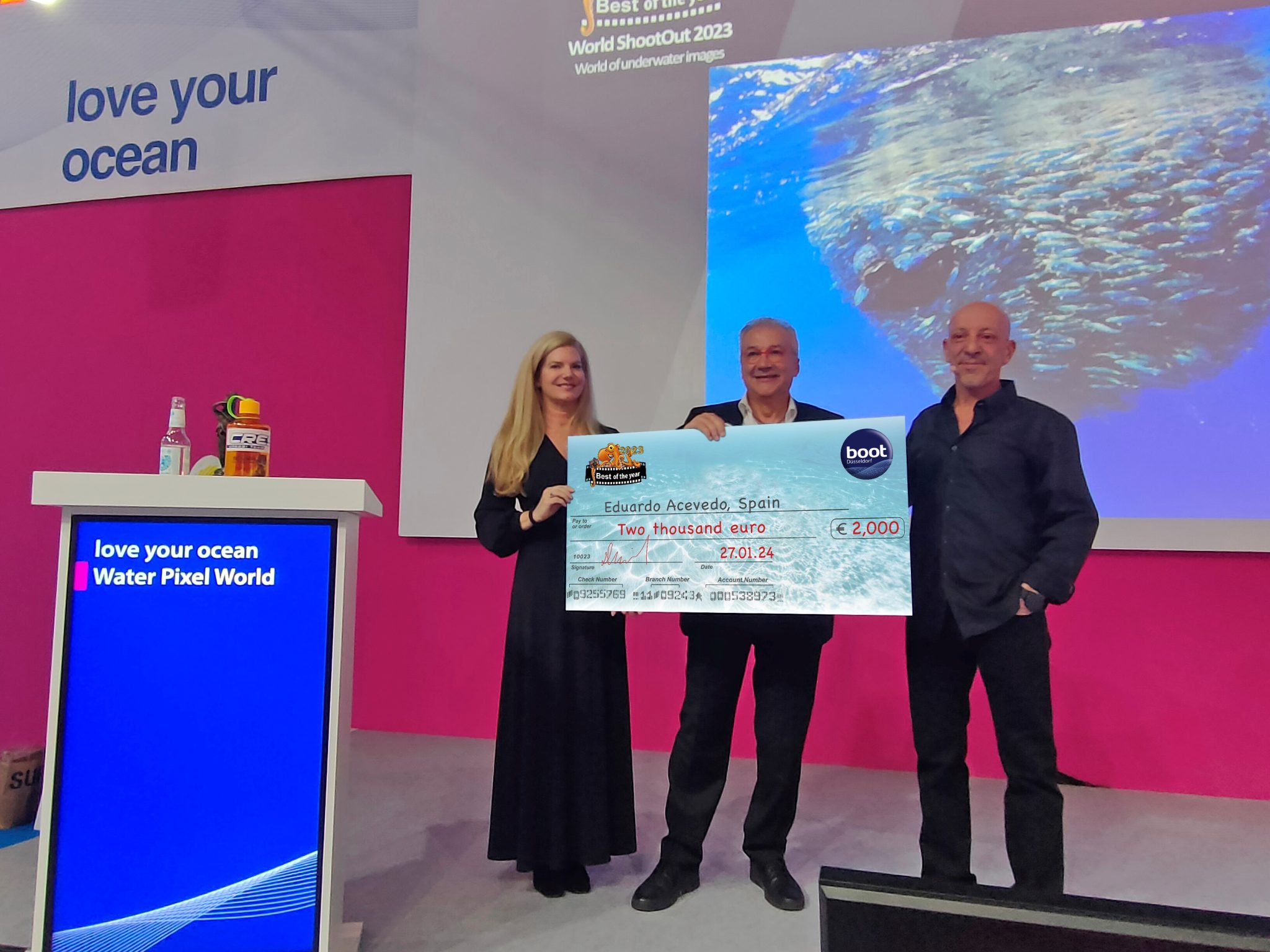
The winners of the prestigious World Shootout 2023 underwater photography competition were announced at this year’s BOOT Show, captivating audiences at the world’s largest diving and water sports exhibition in Dusseldorf, Germany. Hundreds of photographers from 54 countries competed across nine categories, pushing the boundaries of creativity and technical skill.
Grand Prize Winners
- Picture of the Year: Spanish photographer Eduardo Acevedo “secured” the top Honor with the prestigious prize the “boot Dusseldorf Director’s Prize, earning an Andromeda statuette and a €2,000 cash prize.
- Best 5 Images Portfolio: Luc Rooman from Belgium triumphed in this category, winning a dream 4-week diving trip for two to Papua New Guinea, valued at $18,900.
- Amateur Photographer: Alexandra Ceurvorst from the USA impressed the judges with her talent, taking home the 1,000 € cash prize award.
Celebrating Diversity and Innovation
This year’s competition saw 11,680 entries from 964 photographers, showcasing a remarkable spectrum of skills and perspectives. From the intricate wonders of Macro photography to the beauty of “Black Water”, the “Underwater Fashion” category added a touch of artistry and innovation, while the ever-important ” Environmental & Conservation” category served as a powerful reminder of the need to protect these fragile ecosystems.
Looking Ahead: AI and Ocean Conservation
World Shootout founder and producer David Pilosof unveiled an exciting addition for the 2024 competition: this year the Environmental category will be focusing on the impact of plastic on our oceans and future.
This category will embrace the potential of AI or other editing software as a tool to amplify the conservation message.
Entrants will submit campaigns of three original underwater photographs dealing with plastic pollution, along with their final AI assistance processing. This innovative approach encourages artistic expression while raising awareness about a critical environmental issue.
Explore the Stunning Collection
Discover the complete album of competition entries by clicking here.
For Low-resolution photos of finalist entries in eight categories, click here.
-

 News3 months ago
News3 months agoHone your underwater photography skills with Alphamarine Photography at Red Sea Diving Safari in March
-

 News3 months ago
News3 months agoCapturing Critters in Lembeh Underwater Photography Workshop 2024: Event Roundup
-

 Marine Life & Conservation Blogs2 months ago
Marine Life & Conservation Blogs2 months agoCreature Feature: Swell Sharks
-

 Blogs2 months ago
Blogs2 months agoMurex Resorts: Passport to Paradise!
-

 Blogs2 months ago
Blogs2 months agoDiver Discovering Whale Skeletons Beneath Ice Judged World’s Best Underwater Photograph
-

 Marine Life & Conservation2 months ago
Marine Life & Conservation2 months agoSave the Manatee Club launches brand new webcams at Silver Springs State Park, Florida
-

 Gear Reviews3 months ago
Gear Reviews3 months agoGear Review: Oceanic+ Dive Housing for iPhone
-

 Gear Reviews2 weeks ago
Gear Reviews2 weeks agoGEAR REVIEW – Revolutionising Diving Comfort: The Sharkskin T2 Chillproof Suit
















